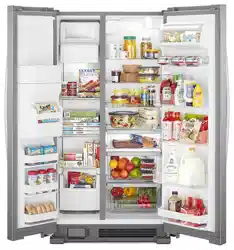Documents: Go to download!
- Owner's manual - (English, French)
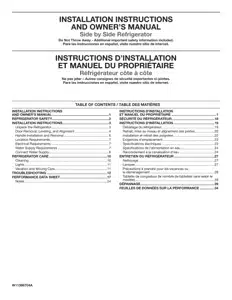
User Gudie Whirlpool WRS325SDHZ04 Refrigerator
TABLE OF CONTENTS
- INSTALLATION INSTRUCTIONS
- AND OWNER’S MANUAL
- REFRIGERATOR SAFETY
- INSTALLATION INSTRUCTIONS
- Unpack the Refrigerator
- Door Removal, Leveling, and Alignment
- Handle Installation and Removal
- Location Requirements
- Electrical Requirements
- Water Supply Requirements
- Connect Water Supply
- REFRIGERATOR CARE
- Cleaning
- Lights
- Vacation and Moving Care
- TROUBLESHOOTING
- PERFORMANCE DATA SHEET
PLEASE KEEP THESE INSTRUCTIONS
- Plug into a grounded 3-prong outlet.
- Do not remove the ground prong.
- Do not use an adapter.
- Do not use an extension cord.
- Disconnect power before servicing.
- Replace all parts and panels before operating.
- Remove doors from your old refrigerator.
- Connect only to the potable water supply.
- Use non-flammable cleaner.
- Keep flammable materials and vapors. such as gasoline. well away from the refrigerator.
- Use two or more people to move and install the refrigerator.
- Disconnect the power before installing the ice maker (on ice maker kit-ready models only).
- Use a sturdy glass when dispensing ice (on some models).
INSTALLATION INSTRUCTIONS
Unpack the Refrigerator
- Remove packing materials. Do not use sharp instruments. rubbing alcohol. flammable fluids. or abrasive cleaners to remove tape or glue. These products can damage the surface of your refrigerator. For more information. see “Refrigerator Safety.”
WARNING
- Suffocation Hazard
- Remove doors from your old refrigerator.
- Failure to do so can result in death or brain damage.
- Important information to know about disposal of refrigerants: Dispose of refrigerator in accordance with Federal and Local regulations. Refrigerants must be evacuated by a licensed.
Excessive Weight Hazard
- Use two or more people to move and install refrigerator.
- Failure to do so can result in back or other injury.
- When Moving Your Refrigerator: Your refrigerator is heavy. When moving the refrigerator for cleaning or service. be sure to cover the foor with cardboard or hardboard to avoid foor damage. Always pull the refrigerator straight out when moving it. Do not wiggle or “walk” the refrigerator when trying to move it. as foor damage could occur.
- Important information to know about glass shelves and covers: Do not clean glass shelves or covers with warm water when they are cold. Shelves and covers may break if exposed to sudden temperature changes or impact. such as bumping.
- Tempered glass is designed to shatter into many small. pebble-size pieces. This is normal. Glass shelves and covers are heavy. Use both hands when removing them to avoid dropping.
- Door Removal. Leveling. and Alignment
- Gather the required tools and parts and read all instructions before starting installation. Save these instructions for future reference.
NOTE:
- Before moving your product into your home. measure the doorway of your home to see whether you need to remove the refrigerator and freezer doors. If door removal is necessary. see the instructions below.
IMPORTANT:
- Before you begin. unplug refrigerator or disconnect power. Remove food. the ice storage bin (on some models). and any adjustable door or utility bins from doors.
Electrical Shock Hazard
- Disconnect power before removing doors.
- Failure to do so can result in death or electrical shock.
- Top Left Hinge Door Removal Top Right Hinge
- Left and Right Bottom Hinge
Leveling and Door Closing
Your refrigerator has two front adjustable wheels. See graphic 1.
These are used to level the refrigerator under uneven floor conditions or want the doors to close more easily. Please follow the instructions below:
1. Use a Bubble level to check levelness of floor where the
2. Place the refrigerator into its final location in the kitchen and
3. Fully open both doors. See graphic 1.
4. If your model has water dispensing in the door. please open
5. Pull the base grille toward you from the sides and then from
6. To remove the base grille. twist and pull the right side until this
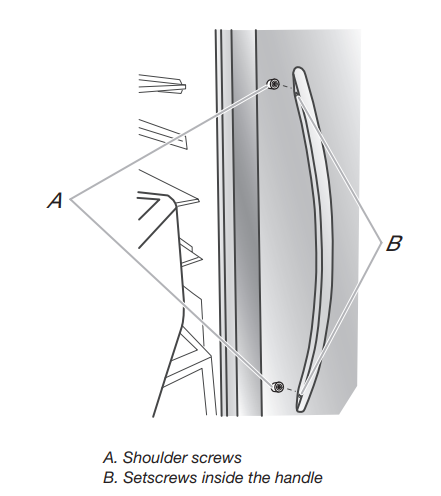
Handle Installation and Removal
PARTS INCLUDED:
- Door handles (2). 1/8" hex key. spare setscrew(s) To Install the Handles: NOTE: The handle mounting setscrews are preinstalled in the handle.
1. Remove the handles. which are packed inside the refrigerator.
NOTE:
- To avoid scratching the finish. place the handles on a towel or other soft surface.
2. Open the freezer door. On the refrigerator door. place the
3. Firmly push the handle toward the door until the handle base
4. While holding the handle. insert the short end of the hex key
5. Using a clockwise motion. tighten the setscrew until it begins
6. Repeat steps 4 and 5 to begin fastening the lower setscrew.
7. Once both setscrews have been partially tightened as outlined
8. Open the refrigerator door and close the freezer door. Repeat
9. Save the hex key and all instructions.

To Remove the Handles:
1. While holding the handle. insert the short end of the hex key
2. Using a counterclockwise motion. loosen the setscrew a
3. Repeat steps 1 and 2 for the upper setscrew. Gently pull the
4. If necessary. use a Phillips screwdriver to remove the shoulder
Location Requirements
- To ensure proper ventilation for your refrigerator. allow for 1/2" (1.27 cm) of space on each side and at the top. Allow for 2" (5.08 cm) of space behind the refrigerator.
- If your refrigerator has an ice maker. allow extra space at the back for the water line connections. When installing your refrigerator next to a fixed wall. leave a 2" (5.08 cm) minimum space on each side (depending on your model) to allow the doors to swing open.
NOTES:
- This refrigerator is intended for use in a location where the temperature ranges from a minimum of 55°F (13°C) to a maximum of 110°F (43°C). The preferred room temperature range for optimum performance. which reduces electricity usage and provides superior cooling. is between 60°F (15°C) and 90°F (32°C). It is recommended that you do not install the refrigerator near a heat source. such as an oven or radiator.
- Normal minimum cabinet cut-out width required for product installation is 36" (91.44 cm). However. if the product is placed against an extended wall and the ability to remove the crisper pans is desired. an additional 18" (45.72 cm) of cabinet width is required. so a total cabinet opening width of 54" (137.16 cm) is recommended.
Electrical Requirements
- Before you move your refrigerator into its final location. it is important to make sure you have the proper electrical connection.
- Recommended Grounding Method A 115 V. 60 Hz. AC only. 15 or 20 A fused. grounded electrical supply is required. It is recommended that a separate circuit serving only your refrigerator be provided. Use an outlet that cannot be turned off by a switch. Do not use an extension cord.
- NOTE: Before performing any type of installation or cleaning. or removing a light bulb. disconnect the refrigerator from the electrical source. When you are finished. reconnect the refrigerator to the electrical source and reset the control (Thermostat. Refrigerator or Freezer Control depending on the model) to the desired setting. See the “Using the Controls” section in the User Instructions. User Guide. or Use and Care Guide.
Water Supply Requirements
- Gather the required tools and parts before starting installation.
- Read and follow the instructions provided with any tools listed here.
Water Pressure
- A cold water supply with water pressure of between 30 and 120 psi (207 and 827 kPa) is required to operate the water dispenser and ice maker. If you have questions about your water pressure. call a licensed. qualified plumber.
- If your refrigerator has a water dispenser: After installation is complete. use the water dispenser to check the water pressure.
- With the water filter removed. dispense 1 cup (237 mL) of water. If 1 cup of water is dispensed in 8 seconds or less. the water pressure to the refrigerator meets the minimum requirement.
- If it takes longer than 8 seconds to dispense 1 cup of water. the water pressure to the refrigerator is lower than recommended. See “Problem Solver” for suggestions.
- Reverse Osmosis Water Supply IMPORTANT: The pressure of the water supply coming out of a reverse osmosis system going to the water inlet valve of the refrigerator needs to be between 30 and 120 psi (207 and 827 kPa).
- If a reverse osmosis water filtration system is connected to your cold water supply. the water pressure to the reverse osmosis system needs to be a minimum of 40 to 60 psi (276 to 414 kPa).
- If the water pressure to the reverse osmosis system is less than 40 to 60 psi (276 to 414 kPa):
- Check to see whether the sediment filter in the reverse osmosis system is blocked. Replace the filter if necessary.
- Allow the storage tank on the reverse osmosis system to refill after heavy usage.
- If your refrigerator has a water filter. it may further reduce the water pressure when used in conjunction with a reverse osmosis system. Remove the water filter. See “Water Filtration System” in the User Instructions. User Guide. or Use & Care Guide.
- If you have questions about your water pressure. call a licensed. qualified plumber.
Connect Water Supply
- Connect to potable water supply only.
- Plumbing shall be installed in accordance with the International Plumbing Code and any local codes and ordinances.
- The gray water tubing on the back of the refrigerator (which is used to connect to the household water line) is a plastic tube. Copper and plastic tubing connections from the household water line to the refrigerator are acceptable. and will help avoid off-taste or odor in your ice or water. Check for leaks.
TOOLS NEEDED:
- Gather the required tools and parts before starting installation.
- Flat-blade screwdriver
- 7⁄16" and 1/2" open-end wrenches or two adjustable wrenches
- 1/4" nut driver
Connect to Water Line
- If you turn the refrigerator on before the water line is connected. turn the ice maker OFF.
Style 1 (Recommended)
1. Unplug refrigerator or disconnect power.
2. Turn OFF main water supply. Turn ON nearest faucet long
3. Use a quarter-turn shutoff valve or the equivalent. served by a
1/2" copper household supply line.
NOTE:
- To allow sufficient water flow to the refrigerator. a minimum 1/2" size copper household supply line is recommended.
4. Now you are ready to connect the copper tubing to the
- Ensure that you have the proper length needed for the job.
- Be sure both ends of the copper tubing are cut square.
- Slip compression sleeve and compression nut onto copper tubing as shown. Insert end of tubing into outlet end squarely as far as it will go. Screw compression nut onto outlet end with adjustable wrench. Do not overtighten.
5. Place the free end of the tubing into a container or sink. and
- Do not use with water that is microbiologically unsafe or of unknown quality without adequate disinfection before or after the system. Systems certified for cyst reduction may be used on disinfected waters that may contain filterable cysts
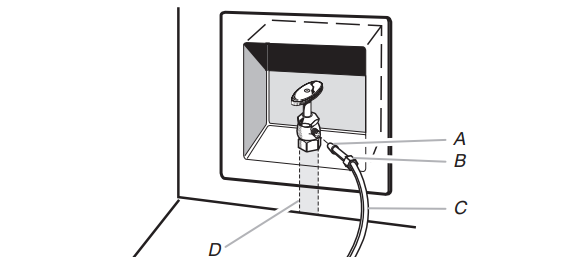
A. Bulb B. Nut
C. Copper tubing (to refrigerator)
D. Household supply line (½" minimum)
A. Compression sleeve B. Compression nut
6. Bend the copper tubing to meet the water line inlet. which
Make sure it is a cold water pipe.
- Horizontal pipe will work. but drill on the top side of the pipe. not the bottom. This will help keep water away from the drill and normal sediment from collecting in the valve.
- Determine the length of copper tubing you need. Measure
- Using a cordless drill. drill a 1⁄4" (6.35 mm) hole in the cold
- Fasten the shutoff valve to the cold water pipe with the pipe
- Slip the compression sleeve and compression nut on
- Place the free end of the tubing in a container or sink. and
Connect to Refrigerator
1.Style 1 1. Unplug refrigerator or disconnect power.
2. Remove and discard the short. black plastic part from the end
3. Thread the nut onto the end of the tubing. Tighten the nut by
4. Install the water supply tube clamp around the water supply
5. Turn shutoff valve ON.
6. Check for leaks. Tighten any connections (including
Style 2
1. Unplug refrigerator or disconnect power.
2. Remove and discard the plastic part that is attached to the
3. Attach the copper tube to the valve inlet using a compression
4. Use the tube clamp on the back of the refrigerator to secure
5. Turn shutoff valve ON.
6. Check for leaks. Tighten any connections (including
7. On some models. the ice maker is equipped with a built-in
Style 3
1. Unplug refrigerator or disconnect power.
2. Remove and discard the black nylon plug from the gray water
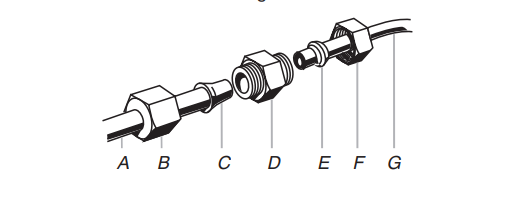
A. Cold water pipe B. Pipe clamp C. Copper tubing D. Compression nut
E. Compression sleeve F. Shut-off valve G. Packing nut
3. If the gray water tube supplied with the refrigerator is not
4. Turn shutoff valve ON.
5. Check for leaks. Tighten any nuts or connections (including
Complete the Installation
1. Plug into a grounded 3 prong outlet.
2. Flush the water system. See “Water and Ice Dispensers” in
NOTE: Allow 24 hours to produce the first batch of ice. Allow 72 hours to completely fill ice container.
Cleaning
- Both the refrigerator and freezer sections defrost automatically.
- However. clean both sections about once a month to avoid buildup of odors. Wipe up spills immediately.
IMPORTANT:
- Because air circulates between both sections. any odors formed in one section will transfer to the other. You must thoroughly clean both sections to eliminate odors. To avoid odor transfer and drying out of food. wrap or cover foods tightly.
To Clean Your Refrigerator:
Do not use abrasive or harsh cleaners such as window sprays. scouring cleansers. flammable fluids. cleaning waxes. concentrated detergents. bleaches or cleansers containing petroleum products on plastic parts. interior and door liners or gaskets. Do not use paper towels. scouring pads. or other harsh cleaning tools.
1. Unplug refrigerator or disconnect power.
2. Hand wash. rinse. and dry removable parts and interior
3. Wash stainless steel and painted metal exteriors with a clean
4. There is no need for routine condenser cleaning in normal
Remove the base grille.
See the “Door Removal” instructions. either in the User Instructions or the Installation Instructions and Owner’s Manual. or in the separate instruction sheet provided with your refrigerator.
Use a vacuum cleaner with a soft brush to clean the grille. the open areas behind the grille and the front surface area of the condenser.
Replace the base grille when finished.
5. Plug in refrigerator or reconnect power.
LED Bulbs
- Incandescent Bulbs
- Or a combination of the above.
- If a Sealed LED Module(s) do not illuminate when the refrigerator and/or freezer door is opened. call whirlpool service for technical support. (See User Guide).
- See "Warranty" for contact information.
- IF a LED Bulb or incandescent bulb does not turn ON when the refrigerator and/or freezer door is opened. replace with a bulb recommended by Whirlpool and following the next procedure:
1. Unplug refrigerator or disconnect power.
2. Remove light cover (in some models)
NOTE:
- To clean the light cover. follow the instructions in REFRIGERATOR CARE section.
3. Remove light bulb and replace with one of the same size.
4. Reinstall light cover (in some models).
5. Plug in refrigerator or reconnect power.
NOTE: Not all appliance bulbs will fit your refrigerator. Be sure to replace the bulb with one of the same size and shape. On some models. the interior lights require a 40 W bulb max.
Vacation and Moving Care
1. Use up any perishables and freeze other items.
2. If your refrigerator has an automatic ice maker and is
3. If you have an automatic ice maker. turn off the ice maker.
NOTE:
- Depending on your model. raise the wire shutoff arm to OFF (up) position or press the switch to OFF (right).
4. Empty the ice bin.
FREEZER SHELF
To Remove and Replace the Bottom Shelf:
1. Lift up the front and back of the shelf. and remove from the
2. Replace the shelf aligning the rods with the cabinet ribs.
- Apply a little pressure on the shelf to attach the rods to the ribs of the cabinet.
- To Remove and Replace the Mid and Top Shelf: 1. With your hand. push the shelf from bottom to top until it is
Refrigerator will not operate
- Not connected to an electrical supply - Plug the power cord into a grounded 3 prong outlet. Do not use an extension cord.
- No power to the electrical outlet - Plug in a lamp to see if the outlet is working.
- Household fuse has blown or circuit breaker has tripped - Replace the fuse or reset the circuit breaker. If the problem continues, contact a licensed electrician.
New installation
- Following installation, allow 24 hours for the refrigerator and freezer to cool completely. NOTE: Adjusting the temperature control(s) to the coldest setting will not cool either compartment (refrigerator or freezer) more quickly.
Motor seems to run too much
- Your new refrigerator has an energy-efficient motor
- The refrigerator may run longer than you’re used to, because the compressor and fans operate at lower speeds that are more energyefficient. This is normal.
NOTE:
- Your refrigerator may run even longer if the room is warm, a large load of food is added, the doors are opened often, or if a door has been left open.
Refrigerator seems noisy
- The compressor in your new refrigerator regulates temperature more efficiently and uses less energy than older models. During various stages of operation, you may hear normal operating sounds that are unfamiliar. The following noises are normal:
- Buzzing/Clicking - Heard when the water valve opens and closes to dispense water or fill the ice maker. If the refrigerator is connected to a water line, this is normal. If the refrigerator is not connected to a water line, turn off the ice maker.
- Cracking/Crashing - Heard when ice is ejected from the ice maker mold.
- Popping - Heard when the inside walls contract/expand, especially during initial cooldown.
- Pulsating/Whirring - Heard when the fans/compressor adjust to optimize performance during normal operation.
- Rattling - Heard when water passes through the water line, or due to the flow of refrigerant. Rattling may also come from items placed on top of the refrigerator.
- Water running or gurgling - Heard when ice melts during the defrost cycle and water runs into the drain pan. Sizzling - Heard when water drips onto the heater during the defrost cycle.
Temperature is too warm
- New installation - Following installation, allow 24 hours for the refrigerator and freezer to cool completely.
NOTE:
Adjusting the temperature control(s) to the coldest setting will not cool either compartment (refrigerator or freezer) more quickly.
- Doors are opened often or not closed completely - This allows warm air to enter the refrigerator. Minimize door openings, keep the doors fully closed, and make sure both doors are properly sealed.
- Air vents are blocked - Remove items that are immediately in front of the vents.
- Large amount of warm food recently added - Allow several hours for the refrigerator to return to its normal temperature.
- Controls are not set correctly for the surrounding conditions - Adjust the controls to a colder setting. Check the temperature again in 24 hours.
Temperature is too cold
- Controls are not set correctly for the surrounding conditions - Adjust the controls to a warmer setting. Check the temperature again in 24 hours.
- Top refrigerator shelf is colder than lower shelves - On some models, air from the freezer enters the refrigerator compartment through vents near the top refrigerator shelf. As a result, the top shelf can be slightly colder than lower shelves.
- Air vents are blocked - Remove items that are immediately in front of the vents.
- Interior moisture buildup NOTE: Some moisture buildup is normal. Clean with a soft dry cloth.
- Room is humid - A humid environment contributes to moisture buildup. Use the refrigerator only in an indoor location, with as little humidity as possible.
- Doors are opened often or not closed completely - This allows humid air to enter the refrigerator. Minimize door openings, keep the doors fully closed, and make sure both doors are properly sealed.
Interior lights do not work
- Doors have been open for an extended period of time - Close the doors to reset the lights.
- Light bulb is loose in the socket or has burned out - On models with incandescent interior light bulbs, tighten or replace the bulb. See the “Lights” section.
NOTE:
- On models with mini LED lights, call for assistance or service if the interior lights do not illuminate when either door is opened. See the Warranty in the User Instructions or User Guide for contact information.
Dispenser lights do not work on some models)
- Dispenser light is turned off - On some models, if the dispenser light is set to OFF, the light will turn on only when a dispenser pad/lever is pressed. If you want the dispenser light to stay on continuously, select a different setting. See “Water and Ice Dispensers” in the User Instructions or User Guide.
- Dispenser light is set to AUTO or NIGHT LIGHT - On some models, if the dispenser light is set to AUTO or NIGHT LIGHT, make sure the dispenser light sensor is not blocked. See “Water and
- Ice Dispensers” in the User Instructions or User Guide.
NOTE:
- On models with mini LED lights, call for assistance or service if the dispenser lights do not
See other models: GU2275XTVY3 GSS26C4XXY04 WDF510PAYS2 GZ25FSRXYY7 WRF989SDAM00
